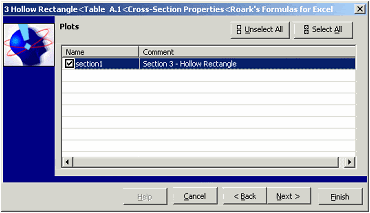Deciding Whether to Use the TK or Excel Version of Roark's Formulas
Customers sometimes ask how they should decide which version of Roark's Formulas to purchase - the TK Solver version, or the Excel version. Here's a bit of guidance:
Our TK Solver version of Roark’s Formulas uses the TK Solver interface and provides direct access to all the formulas, unit conversions, formats, etc. It will take a bit longer to learn all the capabilities but will be more flexible in the long term.
The Excel version of Roark’s Formulas uses Excel as the interface and the TK Solver math models are automatically called as subroutines from within Excel. It’s easy to use right away.
Those who are most interested in a familiar Excel interface should use the Excel version. Those who would like to add TK Solver’s features to their tool box and occasionally “get under the hood” should go with the TK version.
Labels: Excel, roark's formulas, TK Solver
Roark's Formulas for Excel Tutorial - Part 5 of 5
Continue with the annular plate from problem 4 (See the April 20 post). To optimize the design, you would like to specify that the maximum deflection in the center be at most 10% of the plate thickness. You can use the Excel Solver to solve this problem.
Labels: roark's formulas, Roark's formulas for excel, Roark's formulas for stress and strain
Roark's Formulas for Excel Tutorial: Problem 4 of 5
Let's switch from beams to plates. The next problem involves a flat annular plate with uniform annular line load, fixed on the outside and free in the center.
Labels: roark's formulas, Roark's formulas for excel, Roark's formulas for stress and strain
Roark's Formulas for Excel Tutorial - Part 3 of 5
Suppose you decide to stick with the aluminum beam but you’re concerned about the deflection. You’d like to limit the deflection to .1 inch by resizing the beam cross section. For example, if you increase the dimension of side b, the deflection should decrease. The problem is how much do you change side b?
Click here to read more!
Labels: roark's formulas, Roark's formulas for excel, Roark's formulas for stress and strain
Roark's Formulas for Excel Tutorial - Part 1 of 5
Five Quick Problems - Part 1 of 5
Tutorials will use the Standard User Mode to highlight the simplicity in using this software. All Tutorials are shown with the US unit system.
Problem 1 Suppose you are designing a beam with a hollow rectangular section and you need to know the area, moment of inertia, and plastic section modulus.
Start Excel and click on Roark’s Formulas for Excel (RFE) Explorer on the Roark’s Formulas for Excel Toolbar. Select the US unit system and click OK to open the Roark’s Formulas for Excel Explorer.
When the Explorer appears, select Table A.1, Case 3 by either double-clicking it or by clicking on it then clicking the Add button. Your selection is confirmed when it is displayed in the upper right portion of the Explorer screen.
After making your selection, click the Standard User Mode button to continue.
Click the Finish button to link the model into the Excel Worksheet.
You can now explore further on the Excel sheet. Change the inputs, change the units and see the results and plots instantly update.
Click
here to download a
free trial of
Roark's Formulas for Excel.
Labels: roark's formulas, Roark's formulas for excel, Roark's formulas for stress and strain








